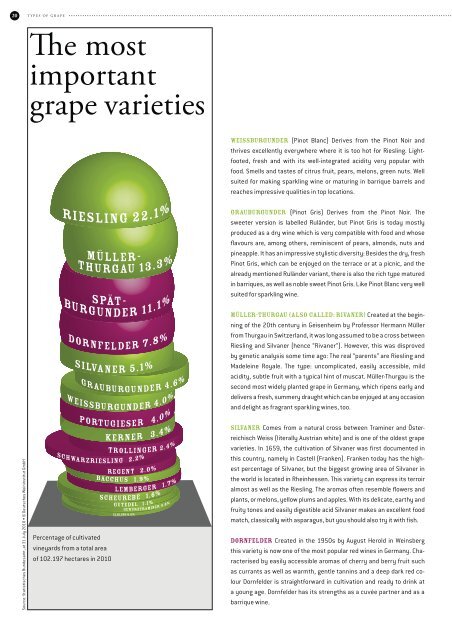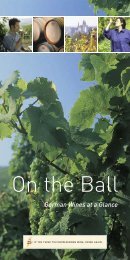the magazine of the german wine institute - Wines of Germany
the magazine of the german wine institute - Wines of Germany
the magazine of the german wine institute - Wines of Germany
Create successful ePaper yourself
Turn your PDF publications into a flip-book with our unique Google optimized e-Paper software.
20<br />
��������������������������������������������������������������������������������<br />
TYPES OF GRAPE<br />
The most<br />
important<br />
grape varieties<br />
Riesling 22.1%<br />
Percentage <strong>of</strong> cultivated<br />
vineyards from a total area<br />
<strong>of</strong> 102.197 hectares in 2010<br />
Müller-<br />
Thurgau 13.3%<br />
Spät-<br />
Burgunder 11.1%<br />
Dornfelder 7.8%<br />
Silvaner 5.1%<br />
GrauBURGUNDER 4.6%<br />
WEISSBURGUNDER 4.0%<br />
Portugieser 4.0%<br />
Kerner 3.4%<br />
Trollinger 2.4%<br />
Schwarzriesling 2.2%<br />
REGENT 2.0%<br />
BACCHUS 1.9%<br />
LEMberger 1.7%<br />
Scheurebe 1.6%<br />
GUTEDEL 1.1%<br />
Gewürztraminer 0.8%<br />
Elbling 0.5%<br />
WEISSburgunder (Pinot Blanc) Derives from <strong>the</strong> Pinot Noir and<br />
thrives excellently everywhere where it is too hot for Riesling. Lightfooted,<br />
fresh and with its well-integrated acidity very popular with<br />
food. Smells and tastes <strong>of</strong> citrus fruit, pears, melons, green nuts. Well<br />
suited for making sparkling <strong>wine</strong> or maturing in barrique barrels and<br />
reaches impressive qualities in top locations.<br />
GRAUburgunder (Pinot Gris) Derives from <strong>the</strong> Pinot Noir. The<br />
sweeter version is labelled Ruländer, but Pinot Gris is today mostly<br />
produced as a dry <strong>wine</strong> which is very compatible with food and whose<br />
flavours are, among o<strong>the</strong>rs, reminiscent <strong>of</strong> pears, almonds, nuts and<br />
pineapple. It has an impressive stylistic diversity: Besides <strong>the</strong> dry, fresh<br />
Pinot Gris, which can be enjoyed on <strong>the</strong> terrace or at a picnic, and <strong>the</strong><br />
already mentioned Ruländer variant, <strong>the</strong>re is also <strong>the</strong> rich type matured<br />
in barriques, as well as noble sweet Pinot Gris. Like Pinot Blanc very well<br />
suited for sparkling <strong>wine</strong>.<br />
Müller-Thurgau (Also called: RIVANER) Created at <strong>the</strong> beginning<br />
<strong>of</strong> <strong>the</strong> 20th century in Geisenheim by Pr<strong>of</strong>essor Hermann Müller<br />
from Thurgau in Switzerland, it was long assumed to be a cross between<br />
Riesling and Silvaner (hence “Rivaner”). However, this was disproved<br />
by genetic analysis some time ago: The real “parents” are Riesling and<br />
Madeleine Royale. The type: uncomplicated, easily accessible, mild<br />
acidity, subtle fruit with a typical hint <strong>of</strong> muscat. Müller-Thurgau is <strong>the</strong><br />
second most widely planted grape in <strong>Germany</strong>, which ripens early and<br />
delivers a fresh, summery draught which can be enjoyed at any occasion<br />
and delight as fragrant sparkling <strong>wine</strong>s, too.<br />
Silvaner Comes from a natural cross between Traminer and Österreichisch<br />
Weiss (literally Austrian white) and is one <strong>of</strong> <strong>the</strong> oldest grape<br />
varieties. In 1659, <strong>the</strong> cultivation <strong>of</strong> Silvaner was first documented in<br />
this country, namely in Castell (Franken). Franken today has <strong>the</strong> highest<br />
percentage <strong>of</strong> Silvaner, but <strong>the</strong> biggest growing area <strong>of</strong> Silvaner in<br />
<strong>the</strong> world is located in Rheinhessen. This variety can express its terroir<br />
almost as well as <strong>the</strong> Riesling. The aromas <strong>of</strong>ten resemble flowers and<br />
plants, or melons, yellow plums and apples. With its delicate, earthy and<br />
fruity tones and easily digestible acid Silvaner makes an excellent food<br />
match, classically with asparagus, but you should also try it with fish.<br />
DornFELDER Created in <strong>the</strong> 1950s by August Herold in Weinsberg<br />
this variety is now one <strong>of</strong> <strong>the</strong> most popular red <strong>wine</strong>s in <strong>Germany</strong>. Characterised<br />
by easily accessible aromas <strong>of</strong> cherry and berry fruit such<br />
as currants as well as warmth, gentle tannins and a deep dark red colour<br />
Dornfelder is straightforward in cultivation and ready to drink at<br />
a young age. Dornfelder has its strengths as a cuvée partner and as a<br />
barrique <strong>wine</strong>.



